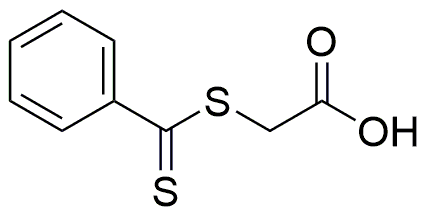S-(Thiobenzoyl)thioglycolic acid is widely utilized in research focused on:
- Cosmetic Formulations: This compound is often used in skin care products for its ability to enhance skin texture and promote a more even skin tone. It acts as a powerful exfoliant, helping to remove dead skin cells and reveal healthier skin beneath.
- Pharmaceutical Applications: In the pharmaceutical industry, it serves as a key intermediate in the synthesis of various drugs, particularly those targeting skin conditions. Its unique properties facilitate the development of effective topical treatments.
- Analytical Chemistry: Researchers utilize this compound in analytical methods for detecting and quantifying thiol-containing compounds. Its reactivity allows for precise measurements, which is crucial in quality control processes.
- Polymer Chemistry: It is employed in the production of specialty polymers, where it acts as a cross-linking agent. This enhances the mechanical properties of materials used in coatings and adhesives.
- Environmental Applications: The compound is also explored for its potential in environmental remediation, particularly in the removal of heavy metals from wastewater. Its chelating properties make it effective in binding and isolating contaminants.
General Information
Properties
Safety and Regulations
Applications
S-(Thiobenzoyl)thioglycolic acid is widely utilized in research focused on:
- Cosmetic Formulations: This compound is often used in skin care products for its ability to enhance skin texture and promote a more even skin tone. It acts as a powerful exfoliant, helping to remove dead skin cells and reveal healthier skin beneath.
- Pharmaceutical Applications: In the pharmaceutical industry, it serves as a key intermediate in the synthesis of various drugs, particularly those targeting skin conditions. Its unique properties facilitate the development of effective topical treatments.
- Analytical Chemistry: Researchers utilize this compound in analytical methods for detecting and quantifying thiol-containing compounds. Its reactivity allows for precise measurements, which is crucial in quality control processes.
- Polymer Chemistry: It is employed in the production of specialty polymers, where it acts as a cross-linking agent. This enhances the mechanical properties of materials used in coatings and adhesives.
- Environmental Applications: The compound is also explored for its potential in environmental remediation, particularly in the removal of heavy metals from wastewater. Its chelating properties make it effective in binding and isolating contaminants.
Documents
Safety Data Sheets (SDS)
The SDS provides comprehensive safety information on handling, storage, and disposal of the product.
Product Specification (PS)
The PS provides a comprehensive breakdown of the product’s properties, including chemical composition, physical state, purity, and storage requirements. It also details acceptable quality ranges and the product's intended applications.
Certificates of Analysis (COA)
Search for Certificates of Analysis (COA) by entering the products Lot Number. Lot and Batch Numbers can be found on a product’s label following the words ‘Lot’ or ‘Batch’.
Numéro de catalogue
Numéro de lot/série
Certificates Of Origin (COO)
This COO confirms the country where the product was manufactured, and also details the materials and components used in it and whether it is derived from natural, synthetic, or other specific sources. This certificate may be required for customs, trade, and regulatory compliance.
Numéro de catalogue
Numéro de lot/série
Safety Data Sheets (SDS)
The SDS provides comprehensive safety information on handling, storage, and disposal of the product.
DownloadProduct Specification (PS)
The PS provides a comprehensive breakdown of the product’s properties, including chemical composition, physical state, purity, and storage requirements. It also details acceptable quality ranges and the product's intended applications.
DownloadCertificates of Analysis (COA)
Search for Certificates of Analysis (COA) by entering the products Lot Number. Lot and Batch Numbers can be found on a product’s label following the words ‘Lot’ or ‘Batch’.
Numéro de catalogue
Numéro de lot/série
Certificates Of Origin (COO)
This COO confirms the country where the product was manufactured, and also details the materials and components used in it and whether it is derived from natural, synthetic, or other specific sources. This certificate may be required for customs, trade, and regulatory compliance.


